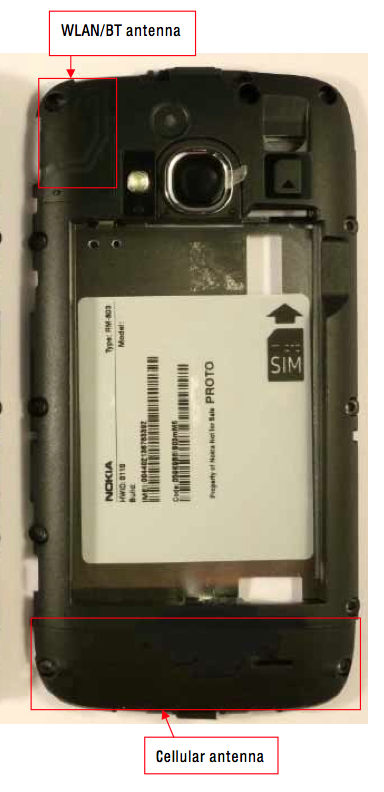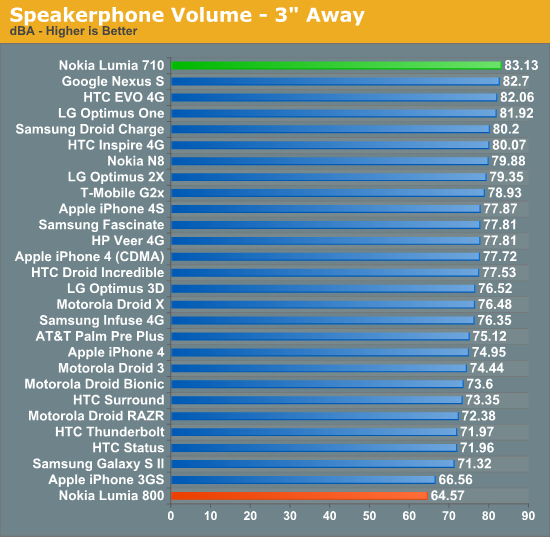Nokia Lumia 710 Review - T-Mobile's Nokia WP7
by Brian Klug on January 5, 2012 12:01 AM EST- Posted in
- Smartphones
- Nokia
- Mobile
- WP7
- Lumia 710
Cellular
Like all MSM8255 devices, the Lumia 710 uses Qualcomm’s onboard combination GSM/EDGE/WCDMA HSPA+ baseband for cellular connectivity. That means HSDPA category 10 on the downlink and HSUPA category 6 on the uplink. Of course, the fact that these HSDPA/HSUPA categories are nothing special at all right now for WCDMA means nothing to T-Mobile, who gladly replaces the “3G” indicator with “4G”.
| Nokia Lumia 710 - Network Support | |||||
| GSM/EDGE Support | 850 / 900 / 1800 / 1900 MHz | ||||
| RM-803 (Europe) WCDMA Support | 900 / 1900 / 2100 MHz (I, II, VIII) | ||||
| RM-809 (T-Mobile USA) WCDMA Support | 850 / 1700 / 1900 / 2100 MHz (I, II, IV, V) | ||||
| Baseband Hardware | QCT MDM8255 w/QTR8615 | ||||
| HSPA+ Categories | HSDPA 14.4 (Cat.10) / HSUPA 5.76 (Cat.6) | ||||
The other noteworthy thing is that the Lumia 710 is also subdivided into two different revisions which carry different WCDMA bands - we were sampled the RM-809 which includes T-Mobile AWS (1700/2100) support. What’s interesting about the RM-809 is that the device also has support for PCS 1900 and Cellular 850, which which means it would work on AT&T, though our device wasn’t unlocked and thus we weren’t able to try. The FCC approval is in place, however. The other Lumia 710 is geared for international support with bands 1, 2, and 8.

I had no issues at all with the Lumia 710 on cellular - connectivity is excellent. Unfortunately I couldn’t get Field Test on the 710 working to read out dBm and check for deathgrip (for some reason it loads indefinitely), however I didn’t see anything odd in my time with the device. In addition I ran speedtests and saw throughput on par with what I expect out of T-Mobile’s HSPA+, though none of the speedtest applications on WP7 allow me to export data and make a nice histogram or two.
WiFi
WLAN connectivity on the Lumia 710 is the standard fare for almost all smartphones these days - 802.11b/g/n (2.4 GHz) single stream. On 20 MHz WLAN channels, that means a physical rate of 72 Mbps, which is precisely what I saw the Lumia 710 authenticate as. I wasn’t able to completely verify, but it seems like a safe bet that BCM4329 is lurking inside. In addition, range signal performance are spot on with where they should be, I saw no issues in my testing.
In our throughput test I saw speeds that almost matched the Lumia 800 (which isn’t surprising at all).

Speakerphone
I spoke a lot about how the Lumia 800’s speakerphone was way too quiet. If the Lumia 800 is one side of the spectrum, the 710 is on the complete other side, as its speakerphone is eardrum-shatteringly loud. In our sound datalogger test, the Lumia 710 placed literally at the top of the ranks for volume, so if you absolutely need speakerphone volume the 710 is an excellent pick. Earpiece volume is also subjectively top notch.

In the call quality department I did the usual thing and recorded samples from the 710 on line in, placed a few calls, and tested noise rejection. The 710, like all WCDMA devices, sounds great to me, though GSM call quality is a bit reduced.
The Lumia 710 does do noise rejection, which has worked its way down from the $200 “superphone” category all the way to the $50 category over the last year or so. The device does common mode noise rejection and some fancy DSP to isolate and cancel noise, and though I’m not sure what IP is in place here (possibly Qualcomm’s Fluence since I don’t see a discrete solution on the board) it does a good job in our test.
GPS
The Lumia 710 unsurprisingly uses the GPS/GLONASS (GNSS) system onboard MSM8255 and accompanied by QTR8615 which we’ve seen numerous times before. Though WP7 doesn’t have API access to NMEA data so we can see SNR from individual satellites, the Lumia 710 does seem to get a GPS lock speedily enough even in some tough environments. In both the maps application and Nokia Drive I had no issues getting a GPS lock in under 5 seconds and keeping the lock for the duration of navigation.










48 Comments
View All Comments
PubFiction - Sunday, January 8, 2012 - link
Nokia may be working on their new core competency. Lots of companies do this same thing and roll just fine. Vizio, Apple to name a few. Do the design then outsource everything else.PubFiction - Sunday, January 8, 2012 - link
I should also add that nokia tried to make symbian work and they failed. They have gone from one of the worlds most recognised phone makers to almost nothing. I mean you can go into any phone provider in the US and I am not sure if you would see any nokia phones.So ya the whole making a competing OS in Europe thing just did not work out for them.
a5cent - Monday, January 9, 2012 - link
Symbian was not doomed due to it being developed in Europe. One of the main difficulties was that the developer was essentially a hardware company. Hardware and software development are very different, and requires a different company culture and different management. American hardware companies that attempt software almost always fail as well. Apple is probably the only exception... Apple is probably the worlds only systems company.Spivonious - Thursday, January 5, 2012 - link
Windows has poor multithreading? What are you talking about? Windows has supported multi-tasking (which is what I assume you mean, since only recently (last 5-10 years) have we gotten CPUs capable of operating more than one thread at a time) since Windows 1.0.WP7 has supported multi-tasking since launch. The API was opened up to 3rd party developers with the 7.5/Mango update.
As an owner of a WP7 phone and a user of iOS, Android, and RIM, I can veritably say that it is the best, most well-designed mobile OS out right now.
Apple doesn't make iPhones either. You may as well get over losing your factory job and realize that in the world economy, you make the product whereever you can get the best deal.
melgross - Thursday, January 5, 2012 - link
I haven't read past the first page yet, but the weights caught my eye. I don't know if the weight in grams is correct, or the weight in ounces, but there is a discrepancy.Assuming that grams is correct, the weight, in ounces, of the 800 should be 4.41, and the weight of the 710 is pretty close, but is then a bit more at 4.43.
jsv35 - Thursday, January 5, 2012 - link
Thank you for taking time and doing reviews on Windows Phone, it's always nice to see. I have an android device myself, but have always kind of liked the look of WP7zinfamous - Thursday, January 5, 2012 - link
Agreed.I don't follow the GPU and general hardware reviews as much as I used to, but the scope of those is what brought me to AT in the first place. I now see that same level of detail now with the phone reviews, and I would never purchase a phone without getting the skinny from AT first.
They have become the best on the web. Even the camera reviews are (were?) just as detailed at one time.
Kudos.
melgross - Thursday, January 5, 2012 - link
What I found interesting is that while neither the 800 or the 710 performed well, though as expected, the LCD screen of the 710 is MUCH brighter than the AMOLED screen of the 800, both phones performed much better than the extremely dismal performance of the N8, a phone which, for some unexplainable reason, is thought by some to be a super phone. To me, it seems a dud.kyuu - Thursday, January 5, 2012 - link
While integration/overlap with Windows on the PC and with the Xbox is certainly an interesting proposition and would be a boon, that's not what I (and probably a lot of others) are waiting for in order to jump ship to the Windows Phone platform. I love the WP UI, I love the *idea* (though not execution so far) of the controlled hardware platforms as opposed to Android's uncontrolled, fragmented mess and the singular, completely restricted iPhone platform.What I'm waiting for to jump are:
1) A more modern hardware platform. I understand all the arguments about why WP doesn't *need* a dual-core yadda yadda, but I have no interest in side-grading from my iPhone 4 to a hardware platform with pretty much exactly the same capabilities. I want an *upgrade* for my investment. And besides, when the hardware capability is there, the software that takes advantage of it will follow suit, and I've seen plenty of reports that 3rd-party Silverlight-based software does indeed suffer slowdown. I need at least a dual-core with a reasonably capable GPU.
2) I need an SD-card slot or some other way to increase the available storage. High-end devices with 8, 16, or even 32GB of NAND with no upgradability is simply not sufficient.
3) A quality screen with a pixel density that's at least competitive with what my iPhone 4 has. I don't want to downgrade to a screen that's looks worse.
I'm hoping by the end of this year with WP8 out, attractive hardware will be out so I can jump to the Windows Phone platform and never look back.
a5cent - Friday, January 6, 2012 - link
Excellent! I agree, and wonder how many other people feel similarly. I suspect you almost have to be a software developer to really appreciate the benefits of the controlled hardware platform. Microsoft's ability to guarantee that every WP device owner will get every update is one such benefit. However, other benefits that are more easily appreciated by end users have yet to materialize.I don't know about expandable storage, but we know the other issues will be resolved with WP8.
I'm also holding on to my current phone. I will also go for WP8 if:
a) we get very tight integration between W8 and WP8
b) we get some AAA applications and games directly from MS which make use of WP8 hardware